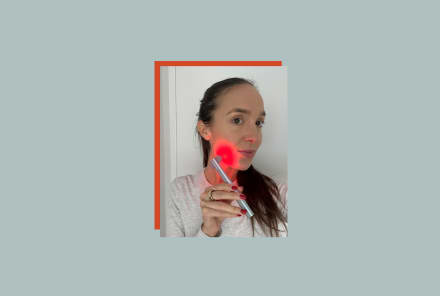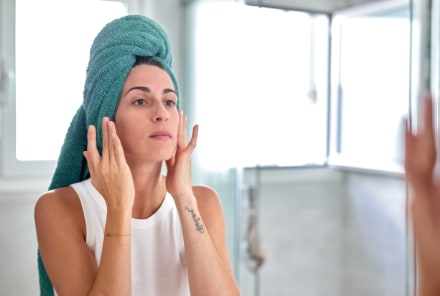Advertisement
How To Grow Your Hair Out: 6 Tips From Hairstylists + How To Style Any Awkward Phases

Once you've decided to grow out your short 'do, the transition phase can be a bit grueling to tackle. Whether you've decided to go for the big chop (aka, cutting off all of your relaxed hair to grow out your natural texture) or are over your pixie cut, you may be wondering: How can I grow out my hair, and how long will it take?
Which is why we want to share everything we've learned about growing out short hair, plus how to style it during those in-between stages. Below, you'll find a bank of hairstylist tips and tricks.
How long does it take for hair to grow?
Timing does vary from person to person, but hair typically grows half an inch per month on average (if you do the math, that's 6 inches of growth per year), no matter the texture of your strands. Although if you do have curls, you also may have to account for shrinkage: "The hair can deceivingly appear as if it's grown half of that," says texture specialist and artistic director at Matrix Michelle O'Connor. To truly assess your progress, hairstylist Miko Branch, co-founder of natural hair care brand Miss Jessie's, suggests gently stretching your curls with your fingers in order to see the length.
Of course, if your strands are dry, brittle, and frayed, that could slow the growth quite substantially. That said, a key component of growing out short hair is to help strengthen the hair you have.
6 tips to grow your hair out.
These six tips below are necessary for piling on those inches:
Decrease your use of hot tools.
You may be itching to heat-style your hair, lest you encounter an awkward phase or two when embarking on your hair growth journey. While you might want to reach for the trusty blowdryer and blast those strands smooth, those hot tools may do more harm than good when it comes to healthy hair growth. "Avoiding hot tools is a great way to protect your hair from heat damage as it grows," says Nick Stenson, celebrity hairstylist and artistic director at Matrix.
Now, the occasional blow-dry won't blow all your progress (just make sure you always incorporate a thermal protectant), but if you're partial to heat styling each and every day, you might want to cut back and give your hair a break. Branch agrees: "Air-dry is the best dry," she notes.
Wear protective styles.
For those with textured or natural hair, you might want to rely on protective styles, especially as you begin the journey from short to long. As Branch has previously told us about hair growth, "Protective hairstyles are wonderful for growing hair out, transitioning between two different hair textures (i.e., textured versus straightened), minimizing the daily hair routine, covering the ends of hair, and safeguarding natural hair against harsh seasonal elements and damaging environmental factors."
Think box braids, flat twists, jumbo cornrows, and so much more; just remember to switch out the braids every two to three weeks (this prevents hair breakage, says Branch) and make sure they aren't pulled too tightly—chronic too-tight hairstyles can lead to traction alopecia, a medical condition that causes hair loss.
Moisturize your hair.
You've likely heard it once or twice by now: Healthy hair grows faster. Not only does nourished, conditioned hair appear longer and fuller, but nourishing also prevents breakage and split ends (which, it turns out, can hinder hair growth). That's why hydration is key for transitioning your hair, especially if your tresses are brittle and fragile already. Tending to the strands with treatments (like this softening treatment and this strengthening conditioner) can help lock in moisture and improve the integrity of your hair.
Cleanse the scalp.
And in terms of the scalp, cleaning and moisturizing the skin is imperative for healthy hair growth—after all, that growth starts up top in those follicles. When you don't cleanse the scalp effectively, you can accumulate buildup (from dirt, oil, and products) that can actually block the opening of the follicle. "That buildup starts to slowly suffocate your hair root," trained trichologist and hairstylist Shab Reslan has told us, which can limit or affect the quality of hair growth.
That said, make sure you're cleansing the scalp as needed, with a good shampoo. The specific products may vary, depending on your scalp type (some have drier scalps in need of moisture, others have oily scalps prone to buildup), but everyone needs a gentle wash on the regular.
Try supportive supplements.
Approaching hair growth internally is a great way to promote healthy, long locks (growth stems from inside those follicles, after all). That's where targeted supplements come in, to promote hair growth from the inside out.*
Specifically, "Supplements that contain biotin are a great additional source of nutrients," says O'Connor.* That's because biotin provides the body with specific amino acids that make up keratin, which is what makes up each strand of hair. Research has even shown that low levels of biotin are linked to hair loss1.* In addition to that famed B vitamin, collagen can also provide the body with those keratin-building amino acids; perhaps that's why studies have found taking both of these supplements can support hair growth2.*
Get regular trims—really!
OK, so trimming your ends doesn't actually stimulate the hair follicles—but snipping split ends is necessary for staving off breakage, which ultimately can lead to slower growth. Whether you opt for a micro-trim or a hair "dusting" just to eliminate the frays, well, that's up to you.
But according to Stenson, you may want to choose a regular trim, as it can keep awkward phases to a minimum. "By regularly trimming up the neckline and keeping it manicured for the first few months, [clients] are able to then grow their hair beyond the one length bob with fewer awkward stages," Stenson says. It sounds a bit counterintuitive—shouldn't growing out your hair require fewer trims?—but consider it a necessary tuneup for healthy, even growth.
How to style your hair as it grows out.
While stashing your hot tools might be best as you grow out a long mane, you can still have fun with styles (and hide any awkward stages, while you're at it). Branch offers more than a few tips to try once you tuck your blowdryer away: "Play with wigs. Switch your hair part from one side to another, or try a middle hair part. Tuck hair under the nape of your neck with pins for a quick bob. Don a stunning high ponytail piece." The world is your oyster.
O'Connor is also partial to fun hairpieces for transitioning hair, like embellishments and bold headbands. She's also on board with switching up your part: "Side parts are always chic on short hair, regardless of its straight or curly," she adds.
The takeaway.
While growing out short hair takes some time, there are a host of things to do to speed up the growth process, as well as styling tips to look chic at every stage. To spur growth and minimize in-between, awkward phases, keep these suggestions top of mind for your healthiest head of hair yet.
Watch Next
Enjoy some of our favorite clips from classes
Enjoy some of our favorite clips from classes
What Is Meditation?
Mindfulness/Spirituality | Light Watkins
Box Breathing
Mindfulness/Spirituality | Gwen Dittmar
What Breathwork Can Address
Mindfulness/Spirituality | Gwen Dittmar
The 8 Limbs of Yoga - What is Asana?
Yoga | Caley Alyssa
Two Standing Postures to Open Up Tight Hips
Yoga | Caley Alyssa
How Plants Can Optimize Athletic Performance
Nutrition | Rich Roll
What to Eat Before a Workout
Nutrition | Rich Roll
How Ayurveda Helps Us Navigate Modern Life
Nutrition | Sahara Rose
Messages About Love & Relationships
Love & Relationships | Esther Perel
Love Languages
Love & Relationships | Esther Perel

















